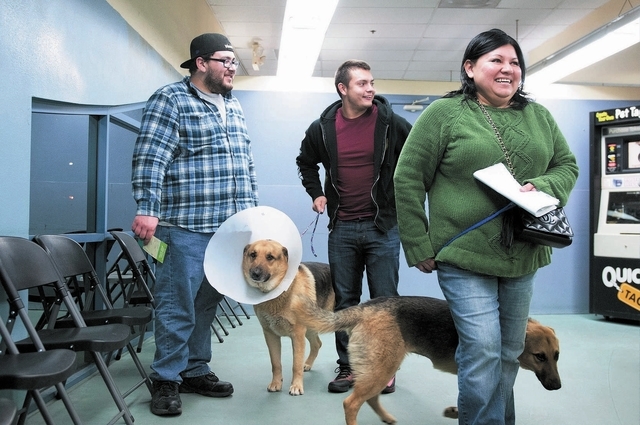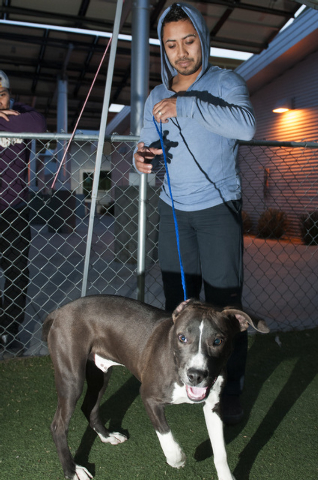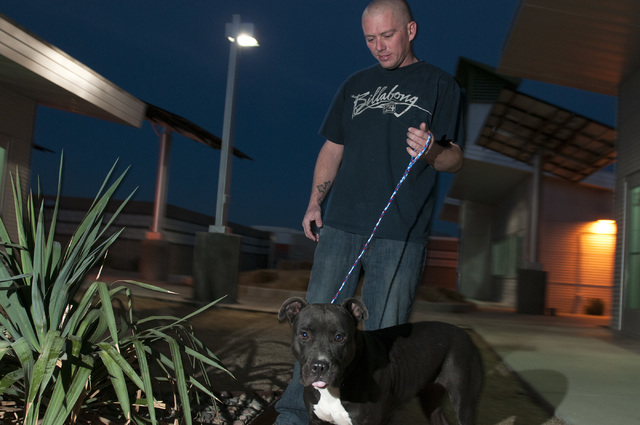New Las Vegas group wants animal shelter to be no-kill operation
A new grassroots organization wants to turn Southern Nevada’s largest animal shelter into a no-kill operation.
No Kill Las Vegas, an incorporated nonprofit, was formed after a November rally about the issue led by Bryce Henderson, a former volunteer at the Animal Foundation’s shelter.
Henderson and his wife, Jennifer, along with their members are pushing for the shelter to make changes such as boosting marketing, using all of its space and only euthanizing animals that are a threat or terminally ill.
Animal Foundation administrators, who oversee the Lied Shelter and its pet adoption areas, say turning the facility into a no-kill shelter isn’t as realistic as advocates portray, given the large volume of animals that come in every year. In 2013, about 40,000 dogs and cats entered the shelter.
Its the largest pet intake facility in the country, with about 100 employees.
The foundation contracts with Clark County and the cities of Las Vegas and North Las Vegas to house animals that are brought in for 72 hours. Those contracts total $3.9 million annually. During that 72-hour period, the animals are not up for adoption, but can be reunited with their owners when possible.
After the three-day period ends, animals may be euthanized, sent to the foundation’s adoption facility or turned over to rescue organizations. When the animals are moved to the campus’ adoption area, their care isn’t paid by the municipal and county contracts. The nonprofit foundation’s other funding must cover those costs.
Henderson’s organization, since its start in December, already has some 500 members. In addition to pushing for a no-kill shelter, it says replacing the shelter’s manager is necessary to bring about the change
“We’ll be able to really show to the elected officials that we’re an organized group and we’re here to stay,” he said.
Christine Robinson, executive director of the Animal Foundation, stressed that the shelter wants to keeps its euthanasia rates down.
That also happens by educating the public, lowering the number of animals that enter the shelter, increasing adoptions and using rescue organizations, she said.
In 2013, 19,776 dogs and cats were euthanized at the shelter, roughly half of the nearly 40,000 that entered that year, according to preliminary statistics. That’s a 20.8 percent decrease in euthanasias, or more than 5,000 fewer cases of euthanized animals, according to the shelter.
At the same time, fewer animals are entering the shelter. In 2010, the number was 51,227. It has dropped each year since then. Factoring in other animals, such as chickens, ponies and goats, the preliminary number of animals entering in 2013 was 40,634.
Robinson credits the changes to a variety of factors. In 2010, cities and the county passed ordinances requiring spaying and neutering. The shelter has a Twitter account that tweets about found pets. It also has a program that allows foster pet owners to temporarily care for animals, and possibly adopt them in the end.
Euthanized animals include those that are contagious and could infect others, making more animals sick, she said. Animals with infections also cannot be in the general population and have to be in the isolation area, which has limited space.
“It’s the hard decision, but it’s the right decision,” Robinson said about euthanization under such circumstances.
Also, the shelter gets slightly more than 100 animals on a daily basis, and there is constant movement between the building where animals are held for the first 72 hours and the adoption area, Robinson said.
As a result, a space that’s empty one moment might get an animal a couple of hours later, she said.
Henderson and his organization’s supporters aren’t convinced.
“They still kill animals there even when they have shelter space open,” he said.
Henderson said the Animal Foundation has plenty of room for improvement, pointing to the euthanasia rates in Los Angeles that are lower than the valley’s shelter. L.A. Animal Services euthanized 35.3 percent of its 246,179 dogs and cats brought in between July 2009 and the end of November, according to the agency’s website.
Henderson also points out that other shelters have gone to a no-kill model, including the one in Reno.
The Las Vegas shelter has a troubled history.
In 2007, conditions at the animal shelter — then under different management — forced the euthanization of 1,000 animals in a short period of time.
The Humane Society found disease and overcrowded conditions that “arose not by accident or out of ignorance, but as a result of a systematic policy that prohibited the euthanasia of surplus healthy and, in numerous cases, sick animals,” according to its report issued at the time.
Robinson said the people overseeing the shelter at the time were well-intentioned, but that hoarding animals led to further problems at the shelter.
The overcrowding came in part because the shelter in 2006 gained the contracts to handle animals coming from North Las Vegas and Clark County. It had gained the city of Las Vegas contract in 1995. As a result, the shelter suddenly started handling a larger amount of animals.
Though the shelter has critics, Robinson said, both sides also agree that helping animals is the ultimate aim.
“I think at the end of the day we have very similar goals and that’s to do the best we can for the greatest amount of animals we can,” she said.
Contact reporter Ben Botkin at bbotkin@reviewjournal.com or 702-405-9781. Follow @BenBotkin1 on Twitter.





























